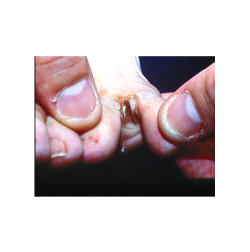
|  |

 |
|
|

|
What are they?
Soft corns are one
of the most painful foot conditions. Soft corns are painful lesions or skin
buildups that occur between the toes. Most frequently, they are located
between the fourth and fifth (small) to es
but can also involve the other digits of the foot. As opposed to the
traditional hard corn that occurs on the top of a toe, these so-called soft
lesions prefer the areas between the digits where there is moisture and
warmth. These lesions are usually quite painful because of persistent
friction and are worsened by shoe pressure. The shape and narrowed forefoot
confinement of the typical woman's dress or business shoe, along with a
raised heel, creates a ripe environment for these soft corns to occur. Once
these soft corns take residence on a foot, it doesn't take long before the
patient needs some help. es
but can also involve the other digits of the foot. As opposed to the
traditional hard corn that occurs on the top of a toe, these so-called soft
lesions prefer the areas between the digits where there is moisture and
warmth. These lesions are usually quite painful because of persistent
friction and are worsened by shoe pressure. The shape and narrowed forefoot
confinement of the typical woman's dress or business shoe, along with a
raised heel, creates a ripe environment for these soft corns to occur. Once
these soft corns take residence on a foot, it doesn't take long before the
patient needs some help.
What causes them?
In many of the cases
involving a painful soft corn, the underlying culprit seems to be a calcium
deposit or small spur of bone lying just beneath the lesion itself.
Sometimes there are spurs on adjacent toes making the condition worse. A
patient can frequently feel this bony prominence by gently palpating the
lesion and feeling a hardened protrusion or bump on the hone itself. As the
soft corn becomes further aggravated and in the absence of professional
care, it may become infected. A soft corn that is surrounded by skin
discoloration is painful to touch, has localized heat or warmth, and is
having a pus or bloody discharge is suggestive of an infection and should be
seen immediately by a foot specialist.
How do you treat them?
The early treatment of a
painful soft corn should include a careful monitoring and selection of shoes
in order to relieve the persistent pressure. Some sort of pad or cotton ball
between the involved toes also helps to relieve the localized pressure and
reduces the discomfort. It infact, separates the spurs from rubbing into
each other. In some instances, a local injection of a steroid or
anti-inflammatory medication can be beneficial in not only reducing the
discomfort but also in shrinking the lesion size itself. In those cases
where the soft corn seems resistant to other measures of care or is so
annoying that the patient strongly desires a corrective course of action,
surgery is a viable treatment option.
|